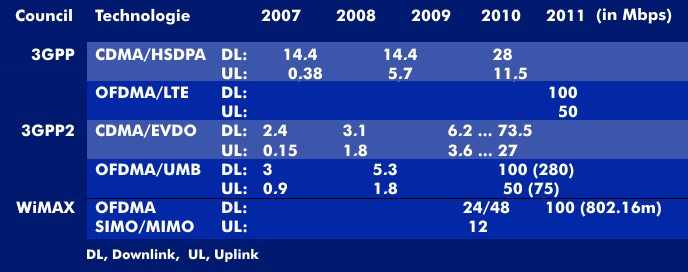ultra mobile broadband (3GPP2) (UMB)
Ultra Mobile Broadband(UMB) is a project initiated by 3GPP2 for high-speed mobile communications. It belongs to the 4th generation of mobile communications systems, competes with Long Term Evolution( LTE) and, like the latter, offers data rates of 100 Mbit/s in the downlink up to peak data rates of 280 Mbit/s. In the uplink, UMB offers data rates of 50 Mbit/s up to peak data rates of 75 MHz. In the uplink, UMB offers data rates of 50 Mbit/s up to peak data rates of 75 MHz.
UMB, like LTE technology, represents the next generation of mobile networks. It has a high data rate, low latency and supports sophisticated services that could not be realized with previous mobile networks, such as Internet telephony( VoIP), high-quality voice communications and real-time transmissions ofHDTV.
The development also took into account compatibility with existing technologies that will be replaced by UMB. As a result, UMB can also operate with CDMA2000 and Evolution Data Optimized( EVDO).
Orthogonal Frequency Division Multiple Access( OFDMA) used in UMB eliminates the disadvantages of Code Division Multiple Access( CDMA) such as adding transmission capacity via microcells and fixed bandwidths that limit the available bandwidth for the mobile terminal. It has scalable bandwidths between 1.25 MHz and 20 MHz, supports the different radio cell sizes such as macrocells, microcells and picocells, uses the architecture ofIP networks and works equally well in flat, centralized and mixed topologies.
While Ericsson promotes Long Term Evolution, Qualcomm is fixated on Ultra Mobile Broadband.

